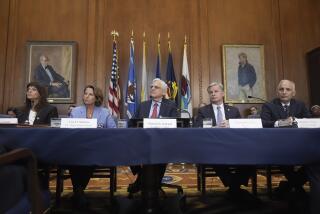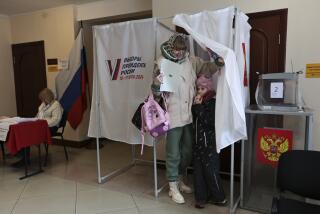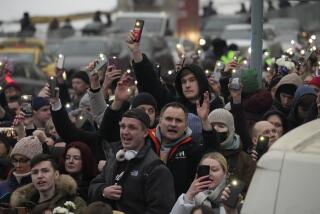Media : Russians Tune Into First TV Campaign : * Candidates try to tug at the heartstrings and pursestrings of voters. Or at least to get their attention for moment.
- Share via
MOSCOW — Joining “Twin Peaks,” “Santa Barbara” and a host of Hollywood oldies this fall on TV screens throughout Russia is another American classic--the campaign spot.
With the Dec. 12 elections less than two weeks away, parties contending for seats in the Duma, the lower house of the new Parliament, are making use of free and paid time on Russian television to bring their messages to an electorate spread across 11 time zones.
TV commercials are relatively new to Russian viewers, who have often had to get along without soap, let alone soap operas; political advertisements, unnecessary in a single-party system, were unheard of until now.
“This is the first television campaign in the history of the country,” said Nikolai Svanidze, a political analyst for Russian Television.
During the perestroika era, candidates for seats in the old Soviet and Russian supreme soviets ran from county-sized constituencies where they were able to glad-hand the locals in person. This time, half the 450 Duma deputies will be elected from nationwide party lists--so ballots will be identical from the Baltic to the Pacific. This makes grass-roots campaigning, especially in such a short campaign, virtually impossible.
“You can’t walk around the whole country,” Svanidze said.
The factory tour-cum-rousing speech, a political staple in the Soviet decades when voting was purely for show, has not disappeared yet. But it is no longer enough, said Vladimir Mironov, chief ideologist of the Future of Russia--New Names party. Even when candidates travel outside Moscow in search of votes, he said, they bring a TV camera and make campaign ads out of the footage.
“In Russia, there is no ‘event’ that is not shown on TV,” Mironov said. “If it’s not on TV, it hasn’t happened.”
And so the 13 political blocs remaining after an initial signature-gathering campaign have taken to the airwaves to push their platforms, using a mixture of stuffed-shirt information sessions and honest-to-goodness political ads designed, with varying degrees of professionalism, to tug at the heartstrings and the purse strings of Russian voters.
Or at least to get their attention.
*
In a recent appearance on national television, Mironov and colleague Vyacheslav Lashchevsky, a former Communist youth organization leader, doffed their jackets, uncorked a bottle of champagne and toasted the viewers, in an apparent attempt to lend their party a youthful, effervescent imidzh.
For the newer parties whose candidate lists lack famous names, the television screen is the only route out of oblivion and onto Russia’s suddenly overpopulated political map.
“Everybody knows Snickers and Mars,” two candy bars so heavily advertised here that they have become the basis for jokes, said Vyacheslav Amelin, president of a media company that made a commercial for the party known as Cedar. “But this party is not so famous.”
Cedar, which is campaigning on an environmental platform, recruited its leader’s 12-year-old daughter to dress up in a traditional Russian folk costume and portray Russia’s bright future in one ad.
Better-known blocs with greater financial resources have sought support outside the family circle.
Russia’s Choice, the favored party headed by First Deputy Prime Minister Yegor T. Gaidar and other government big shots, has enlisted an eclectic panoply of entertainers, from ‘60s generation satirists to teeny-bopper crooners--in short, something for voters of all ages.
In a medley whose refrain is “Russia, arise,” pop stars singing for Russia’s Choice try to appeal to both hungry pensioners and brash young businessmen, urging voters to pray “for those who are suffering and those driving a Mercedes.”
In a bow to the international might of advertising, the song includes a prayer “for the new generation that chose Pepsi.”
But the main theme of these ads is patriotic, evoking the die-hard notion of Russia as a great, if temporarily disabled, power.
Even the pro-reform parties show footage that looks as if it could have come from Stalin-era propaganda films: Cranes swing over hulking building sites; sparks arc in front of the helmeted faces of welders; suns rise over endless forests of tall northern pines; rosy-cheeked children watch rockets blast off over pillars of fire.
Beyond the starchy-clean images of churches standing in fields of unsullied snow, the TV campaign got off to a dirty start. Candidates have accused each other of being alcoholics or using “Stalinist” methods. Angered by opposition criticism of his reforms and a proposed constitution also on the Dec. 12 ballot, Russian President Boris N. Yeltsin last week scolded party leaders, telling them to stop “pouring mud on your rivals.”
The favorite target has been Russia’s Choice, which leads the polls by a healthy margin. The Communists spout statistics documenting the sharp economic and moral decline of the country under the leadership of Russia’s Choice candidates. The centrist Civic Union and the Democratic Party of Russia have used TV time to blame Yeltsin and his government for the fatal storming of Parliament by government troops in October.
Russia’s Choice counters with the bottom line a la russe : “The shelves are full,” boasts one commercial, only to add the refreshingly honest qualifier: “True, not everyone can buy these products. They’re expensive. But we’re on the right track, the track to reform.”
After complaints early in the campaign that Russia’s Choice was dominating the airwaves, Yeltsin set up a special court to judge fairness issues in the TV campaign.
The court mandated an hour of free time for each party on each of the two, state-run national channels. In addition, the channels are offering paid time slots for $700 per minute--a huge discount from the commercial price of about $8,000.
After drawing lots for the free time slots, the parties split their hours into blocks of 20 or 30 minutes, to avoid wasting effort on an early slot only to be forgotten on election day. All but two--the Russian Communist Party and the anti-land reform Agrarian Party--have paid for additional air time.
As the parties try hard to outdo each other on the air, one question remains: Will the ads make a difference?
“There’s a certain monotonous hue to the presentations of the groups,” said Andrei Skriabin, an official responsible for planning campaign coverage at the state TV company, Ostankino. “They tend to blend together in the mind, and as the days pass, the level of viewership will fall.”
*
A Civic Union candidate betrayed a similar fear when, on the very first night of free programming, she addressed a plea to “those of you who are about to change the channel.”
The following evening, Konstantin Kot sat behind the counter of one of the glass-and-steel shops that have sprung up in Moscow recently, lazily channel-surfing via remote on a 21-inch Panasonic selling for about $600. Flipping past a Russia’s Choice ad after a cursory glance, Kot settled on a Mexican soap opera called “Simply Maria.” Asked why he didn’t want to watch the campaign programming, the 25-year-old offered a sour expression.
“We’re all tired of politics,” he said. “Why should I waste my time watching the same mugs who have always been in power?”
More to Read
Sign up for Essential California
The most important California stories and recommendations in your inbox every morning.
You may occasionally receive promotional content from the Los Angeles Times.










